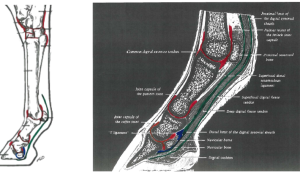Large animal wounds
Synovial involvement
Any wound over a joint or in the region of a tendon sheath should be evaluated for penetration of synovial structures. Remember the joint capsules extend proximally and distally beyond the bones of the joint and that the deep flexor tendon sheath runs on the palmar/plantar surfaces of the lower third of each cannon bone and down through the pastern region.

Synovial involvement can be confirmed by 1) visualizing or feeling smooth cartilage or 2) by trying (and failing) to distend the joint. A normal joint will pressurize. In other words, when you inject fluid, the joint eventually gets full – pressure builds up – and it is hard to inject more fluid.
If a joint is damaged, fluid just leaks out. No pressure develops. To check joint integrity using this technique, the needle should be inserted through a cleaned area of intact skin. Do NOT put the needle through the wound or damaged tissues. If you can inject large volumes of sterile fluid and the joint does not become harder to inject (no pressure develops), it is open. Tendon sheaths can be harder to distend; wrap the unaffected part temporarily with vetwrap to make a smaller space to distend.
If synovial damage is suspected or verified, intravenous antibiotics and NSAIDs should be started immediately or as soon as a culture can be obtained, if a culture is possible. The animal should be hospitalized.
Continued treatment usually entails a combination of regional antibiotic perfusion (horses) and systemic antibiotics. Arthroscopic lavage is used in horses to remove debris and provide high volume flush. In ruminants, the large amount of fibrin usually makes arthrotomy necessary.
Prognosis depends upon the duration of contamination, access to the joint, type of joint (high motion or low motion) and level of performance required.
Key Takeaways
Always think about where the joints and tendon sheaths are in relation to the wound. Evaluate their involvement early on to give your patient the best prognosis. Treatment is often successful if treated early. Waiting for lameness is not a good plan.
Resources
Equine Wounds over Synovial Structures, VCNA Vol.34(3), pp.575-590, 2018

